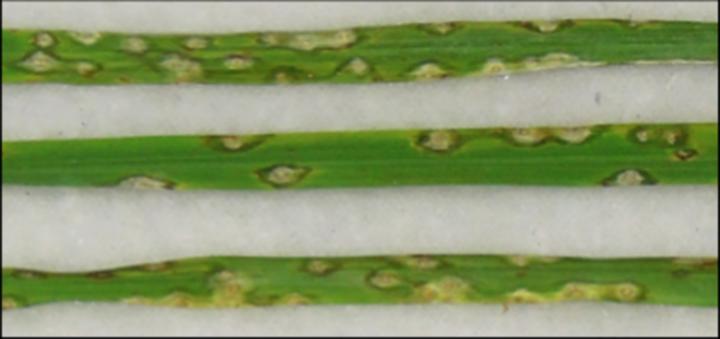Secrets of a rice-killing fungal toxin

Rice blast disease resulting from the mycotoxin tenuazonic acid (produced by the fungus Magnaporthe oryzae). Credit: RIKEN
Mycotoxins are toxic compounds produced by fungi that are not directly involved in growth, development, or reproduction. These secondary metabolites typically colonize crops and are a real economic burden for farmers. TeA is known to be produced by at least three different plant pathogenic fungi, and is associated with spoiling of fruits, vegetables, and food-crops, as well as post-harvest decay.
“Now that we know the gene responsible for biosynthesis of this harmful toxin,” notes co-lead author Takayuki Motoyama, “after further testing we might be able to devise a way to regulate its expression and prevent destruction of important crops.”
When studying microorganisms like fungus, researchers have found that genes for many secondary metabolites are silent under laboratory conditions, which has made finding them especially difficult. The CSRS group led by Hiroyuki Osada has extensive experience studying secondary metabolites, and the team reasoned that OSM1–a gene associated with responses to environmental stress–might also be related to TeA production in Magnaporthe oryzae, a pathogenic rice fungus.
While wild-type M. oryzae did not yield any TeA, researchers were able to produce it from OSM1 knockout strains. They were also able to produce TeA by culturing wild-type M. oryzae with 1% dimethylsulphoxide, perhaps as a response to the unfavorable environment.
Having two methods to produce TeA in the lab proved invaluable for identifying the gene responsible for its biosynthesis. To do so, the team performed a DNA microarray analysis using the total RNA extracted under the two conditions that yielded TeA. Only one gene was found to be expressed significantly more in these conditions than when no toxin was produced.
Further tests were run to determine whether this gene really is responsible for TeA biosynthesis. First, knocking out this gene yielded a strain that could not produce the toxin, and researchers tentatively renamed the gene TeA synthetase 1–or TAS1. Then, the team created an M. oryzae strain that overexpressed TAS1, and as expected, this strain produced the toxin under normal conditions.
Next, researchers examined the structure of TAS1 and found that it is a hybrid enzyme containing an NRPS region followed by a PKS region. “This was very surprising”, explains Motoyama. “It was assumed because of TeA's structure that it would be synthesized by a PKS-NRPS hybrid enzyme. In fact, the order of these regions was totally reversed!” While NRPS-PKS hybrid enzymes have been found in bacteria, TAS1 is the first fungal enzyme for a secondary metabolite to be discovered with an NRPS-PKS structure.
After analyzing how TeA is generated and determining that TAS1 synthesizes it from isoleucine and acetoacetyl-coenzyme A, the researchers searched for homologues in other organisms. While they found several other species of fungi that have genes for homologues sharing the same domain structure, bacterial sources with similar amino acid sequences did not share the same characteristic domain structure. Further research will be needed to find out if this novel enzyme has homologues that biosynthesize other compounds with useful biological functions.
While preventing TeA synthesis might me a goal for crop preservation, TeA also has antitumor, antibacterial, and antiviral properties that could prove beneficial in many situations. Understanding exactly how it is synthesized by TAS1 is therefore an important next step. “Now that we know that the KS domain of TAS1 is unique,” notes co-lead author Choong-Soo Yun, “X-ray crystallographic analysis of this domain will be important for uncovering the reaction mechanism.”
###
This study was supported in part by the Japanese Science and Technology Research Promotion Program for Agriculture, Forestry, Fisheries, and Food Industry.
reference: Yun CS, Motoyama T, Osada H. Biosynthesis of the mycotoxin tenuazonic acid by fungal NPRS-PKS hybrid enzyme. Nature Communications. doi: 10.1038/ncomms9758
Media Contact
All latest news from the category: Life Sciences and Chemistry
Articles and reports from the Life Sciences and chemistry area deal with applied and basic research into modern biology, chemistry and human medicine.
Valuable information can be found on a range of life sciences fields including bacteriology, biochemistry, bionics, bioinformatics, biophysics, biotechnology, genetics, geobotany, human biology, marine biology, microbiology, molecular biology, cellular biology, zoology, bioinorganic chemistry, microchemistry and environmental chemistry.
Newest articles

Combatting disruptive ‘noise’ in quantum communication
In a significant milestone for quantum communication technology, an experiment has demonstrated how networks can be leveraged to combat disruptive ‘noise’ in quantum communications. The international effort led by researchers…

Stretchable quantum dot display
Intrinsically stretchable quantum dot-based light-emitting diodes achieved record-breaking performance. A team of South Korean scientists led by Professor KIM Dae-Hyeong of the Center for Nanoparticle Research within the Institute for…

Internet can achieve quantum speed with light saved as sound
Researchers at the University of Copenhagen’s Niels Bohr Institute have developed a new way to create quantum memory: A small drum can store data sent with light in its sonic…





















